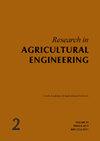一种新型翼凿犁的受力及松动特性
Q3 Agricultural and Biological Sciences
引用次数: 2
摘要
本研究旨在验证带翼凿犁(WCP)在土壤仓中的各种配置的性能。在三个机翼深度(5、10和15 cm)、三个弯曲角度(10、20和30°)和三个前倾角(7.5、15和22.5°)下,使用完全随机设计,分别在30 cm和1 m·s–1的恒定深度和速度下进行三次重复,评估了新工具的性能。试验期间测量了吃水和垂直力、土壤扰动和隆起面积以及土壤松动效率。结果表明,随着机翼深度、弯曲角和前倾角的增加,吃水和垂直力显著增加。土壤扰动面积随着机翼深度、弯曲角度和前倾角的增加而增加。随着机翼深度和弯曲角度的增加,土体的上起伏减小,但前角对土体上起伏面积的影响并不显著。当机翼深度为10 cm、弯曲角度为20°和前倾角为15°时,土壤松动的最大效率为268.1 cm2·kN–1。土壤疏松效率的显著提高以及土壤表面残留的相当大一部分表明,应采用WCP进行保护性耕作。本文章由计算机程序翻译,如有差异,请以英文原文为准。
Forces and loosening characteristics of a new winged chisel plough
This study was devoted to verifying the performance of various configurations of a winged chisel plough (WCP) in a soil bin. The performance of the new tool was assessed at three wing depths (5, 10 and 15 cm), three bend angles (10, 20 and 30 °), and three rake angles (7.5, 15 and 22.5 °) with three replications using a completely randomised design at a constant depth and speed of 30 cm and 1 m·s–1, respectively. The draught and vertical forces, soil disturbed and upheaved areas plus the efficiency of the soil loosening were measured during the tests. The results revealed that the draught and vertical forces were significantly increased by increasing the wing depth, bend and rake angles. The soil disturbance area increased with an increase in the wing depth, bend and rake angles. While the soil upheaving was decreased by increasing the wing depth and bend angle, the effect of the rake angle on the soil upheaving area was not significant. The maximum efficiency of the soil loosening of 268.1 cm2·kN–1 was achieved for a wing depth of 10 cm, a bend angle of 20 °, and a rake angle of 15 °. A significant improvement in the efficiency of the soil loosening along with maintaining a considerable portion of the residue on the soil surface suggest that the WCP should be adopted for conservation tillage.
求助全文
通过发布文献求助,成功后即可免费获取论文全文。
去求助
来源期刊

Research in Agricultural Engineering
Engineering, agriculture-
CiteScore
1.40
自引率
0.00%
发文量
21
审稿时长
24 weeks
期刊介绍:
Original scientific papers, short communications, information, and studies covering all areas of agricultural engineering, agricultural technology, processing of agricultural products, countryside buildings and related problems from ecology, energetics, economy, ergonomy and applied physics and chemistry. Papers are published in English.
 求助内容:
求助内容: 应助结果提醒方式:
应助结果提醒方式:


